The “Ancient Tea Horse Road” took shape during the Qin and Han dynasties and was officially formed during the Tang and Song dynasties. It flourished from the Qing Dynasty to the Republic of China until the middle of the 20th century, when it began to decline with the construction and extension of roads at all levels.
It is not a single road, nor a single transportation mode, but a network of paths that branched out from the main route.
On the “Ancient Tea Horse Road”, many caravans traveled between the Han and Tibetan ethnic groups in southwestern China, transporting commodities such as tea, horses, and salt for trade.
This road, like a galloping great river, kept many ethnic groups in southwestern China closely knitted, strengthening the economic and cultural exchanges and integration among one another, increasing mutual solidarity and friendship, and consolidating the stability of the southwestern frontier.

Chinese people’s love for tea has a long history. People in the Central Plains and the border areas have embedded the tea culture into their daily lives.
Tea in the southwest and horses in the northwest played a balancing and stabilizing role in the construction and stabilization of the ancient dynastic power. Whether tea as a source of daily consumption and national taxes, or horses as a means of transportation and warfare, they were gradually becoming an important medium of communication between north and south, east and west, Central China and the frontier, between the frontier areas, domestic and foreign regions.
Such a demand inevitably brought about mutual dependence between different regions and different nationalities in an agricultural society, which further had an impact on the economy, politics, and culture of ancient China, resulting in the Tea-Horse market and trade that lasted for thousands of years in Chinese history. The boom in trade gave rise to the exchange of more varieties of commodities.

The Ancient Tea Horse Road started from the tea-producing areas of Yunnan, Sichuan and Hunan in the eastern side of Mount Hengduan in southwestern China,
crossing Mount Hengduan and the valleys of the three rivers (Jinsha, Lanchang and Nujiang), and extending westward across the world's highest peaks, snow-capped mountains and grasslands, covering the Yunnan-Guizhou and Qinghai-Tibet plateaus,
and finally reaching the southern Himalayas in the South Asia. It was the most ancient and complex transportation system in the world, and carried a rich culture.

The ancient tea horse road was a route that was created by the people. This road displayed how human beings lived in harmony with nature, and the cultural richness integrating ethnicity, faith, and culture.
The route formed a network for the ethnic minorities of the Yunnan, Sichuan and Tibetan regions, and the movement of people drives the circulation of languages, customs and beliefs, deepening people's knowledge and understanding of one another, while maintaining the diverse cultural characteristics of each ethnic group.
The “Ancient Tea Horse Road” took shape during the Qin and Han dynasties and was officially formed during the Tang and Song dynasties. It flourished from the Qing Dynasty to the Republic of China until the middle of the 20th century, when it began to decline with the construction and extension of roads at all levels. It is not a single road, nor a single transportation mode, but a network of paths that branched out from the main route. On the “Ancient Tea Horse Road”, many caravans traveled between the Han and Tibetan ethnic groups in southwestern China, transporting commodities such as tea, horses, and salt for trade. This road, like a galloping great river, kept many ethnic groups in southwestern China closely knitted, strengthening the economic and cultural exchanges and integration among one another, increasing mutual solidarity and friendship, and consolidating the stability of the southwestern frontier.
Chinese people’s love for tea has a long history. People in the Central Plains and the border areas have embedded the tea culture into their daily lives. Tea in the southwest and horses in the northwest played a balancing and stabilizing role in the construction and stabilization of the ancient dynastic power. Whether tea as a source of daily consumption and national taxes, or horses as a means of transportation and warfare, they were gradually becoming an important medium of communication between north and south, east and west, Central China and the frontier, between the frontier areas, domestic and foreign regions. Such a demand inevitably brought about mutual dependence between different regions and different nationalities in an agricultural society, which further had an impact on the economy, politics, and culture of ancient China, resulting in the Tea-Horse market and trade that lasted for thousands of years in Chinese history. The boom in trade gave rise to the exchange of more varieties of commodities.
Drinking tea is not only a way of life for the Chinese, but also a relationship of cultural and ideological exchange of feelings. Tea brings a variety of benefits, from ancient times to the present, it is a necessity of life in many areas. Due to the lack of fruits and vegetables in the highlands, the reliance on tea is more prominent, which is also one of the causes of the formation of the ancient tea horse road.
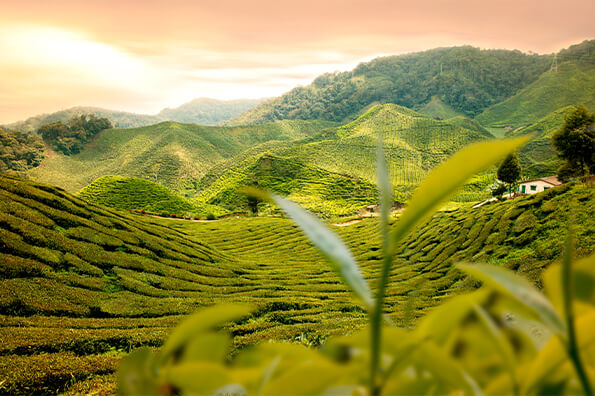
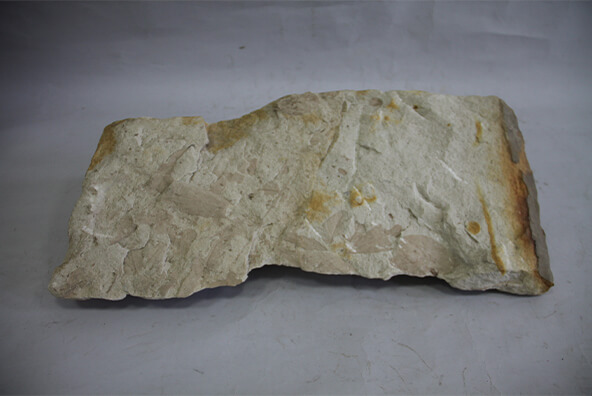
China was the first place in the world to grow tea. The discovery of ancient broad-leaved magnolia fossils in Jinggu confirmed the origin of tea trees in Yunnan. Tea trees and broad-leaved magnolias, Chinese magnolia tree fossils have more similarities and are genetically related. Jinggu County within Simao City is the only distribution area of the magnolias in China.
The tea tree in Jinxiu Village, Xiaowan Town, Fengqing County, Lincang City, Yunnan Province is representative of cultivated ancient tea trees in Fengqing. It has the thickest trunk among ancient tea trees found in the world, and with an age of over 3,200 years, it is known as the “King of Tea Trees”. It grows at an altitude of 2,245 meters, its roots having a circumference of 5.80 meters. The tree stands with a height of 10.6 meters, and has a trunk diameter of 7.84 meters.
The production area of Pu'er tea is centered on the Six Great Tea Mountains in Xishuangbanna, covering the middle and lower reaches of the Lancang River in Yunnan Province. Many ancient tea trees are preserved on the Six Great Tea Mountains, they were recorded in documents of the mid Qing Dynasty as Mansa (Yiwu), Yibang, Youle (Jinuo), Manzhuan and Gedeng, which continue to this day.
The six tea mountains are the source of the Ancient Tea Horse Road in Yunnan Province, and gradually developed into a distribution center mainly for tea trade, exerting huge influences on the politics, economy, production, consumption, traffic and transportation of Yunnan Province.
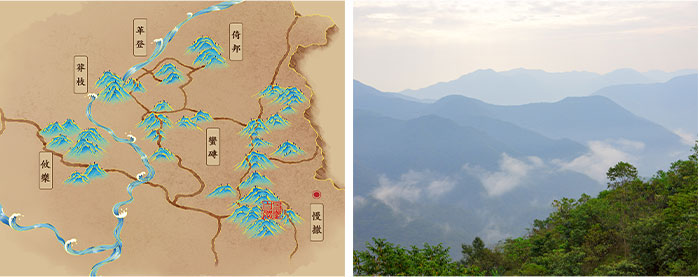
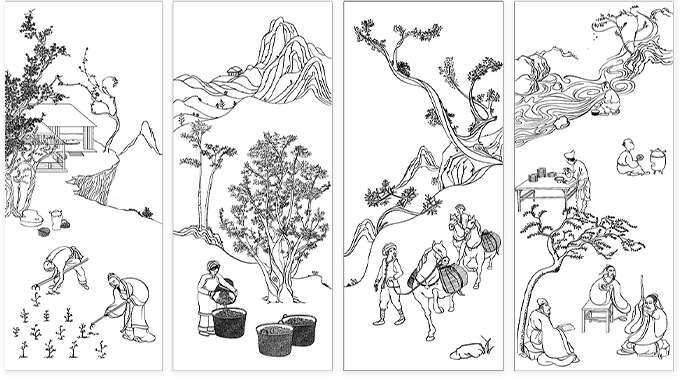 Process of Tea Planting, Tea
Picking, Tea Transportation and Tea Contest
Process of Tea Planting, Tea
Picking, Tea Transportation and Tea Contest
According to legend, during the Three Kingdoms period, when the Kingdom of Shu failed to attack the Kingdom of Wu, the southern counties became rebellious. Zhuge Liang himself went to conquer the south, crossed Lu River in May, and pacified four counties. To stabilize and develop the southwestern region, Zhuge Liang promoted advanced farming techniques among the local ethnic minorities, and promoted the cultivation and use of tea. Therefore, Zhuge Liang is also regarded as the “Ancestor of Tea” in many regions. However, such a legend is not recorded in history books, more out of admiration and learning of the Central Plains culture by the people of southwest China.
In mid-April every year, the Blang people living in the Jingmai Mountain gather at the Tea Ancestor Temple to hold the grand ceremony for the Shankang Tea Ancestor Festival. At the ceremony, people pray for happiness and good luck, awaken the soul of tea, offer sacrifices to the Tea Ancestor and ask for his blessings. The Shankang Tea Ancestor Festival, with a history of more than 1,700 years, is similar to the Spring Festival celebrated by the Han people. On the day, the Blang people bid farewell to the old year and welcome a new one. At the festival, they worship the ancient tea mountains that gave them lives and hope, and offer tributes like glutinous rice, beeswax joss sticks and gift money to their ancestors to pray for happiness and good fortune.
When did Tibetan people start to drink tea? The earliest historical records can be found in the Tang Dynasty. During the Tang Dynasty, when the Tubo kingdom was powerful, tea was also introduced into Tibet as a precious gift. According to Tibetan Diary, in the 15th year of Zhenguan Reign (641), when Princess Wencheng married Songtsen Gampo, the king of Tibet, tea and tea seeds were included in the articles she took with her, which promoted and developed the custom of drinking tea in Tubo.
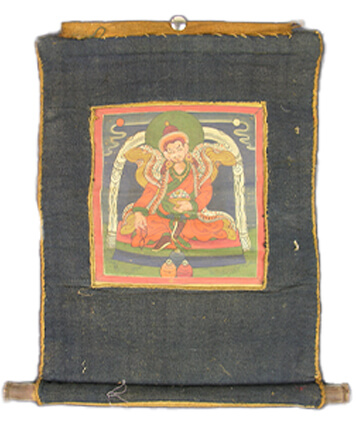 Painted Songtsan Gampo Statue
Thang-ga
Painted Songtsan Gampo Statue
Thang-ga
(Collected in Qinghai Provincial Museum)
When did Tibetan people start to drink tea? The earliest historical records can be found in the Tang Dynasty. During the Tang Dynasty, when the Tubo kingdom was powerful, tea was also introduced into Tibet as a precious gift. According to Tibetan Diary, in the 15th year of Zhenguan Reign (641), when Princess Wencheng married Songtsen Gampo, the king of Tibet, tea and tea seeds were included in the articles she took with her, which promoted and developed the custom of drinking tea in Tubo.
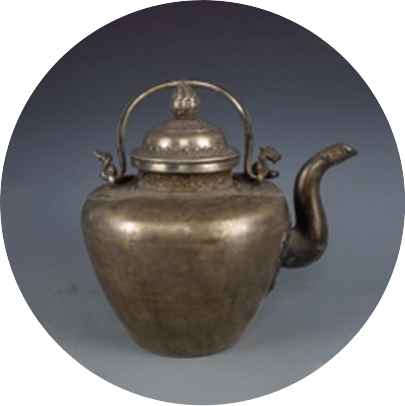 Boiled Green
Tea
Boiled Green
Tea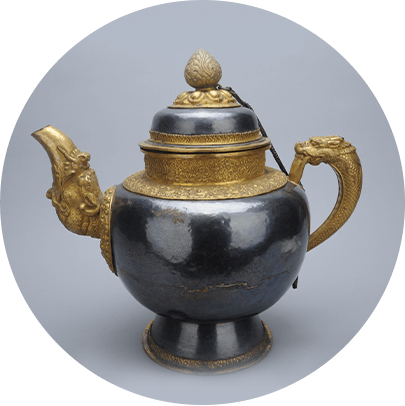 Butter Tea
Butter Tea
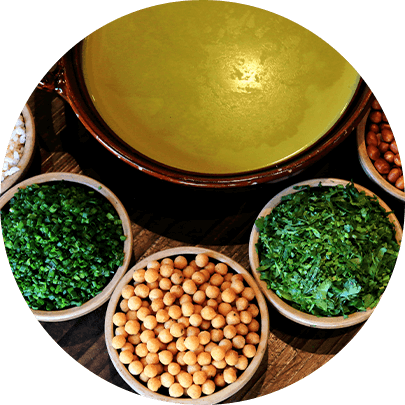 Tibetan Milk
Tea
Tibetan Milk
TeaDue to the differences in customs, tea in northwest China has developed unique and varied tea-drinking styles. Locals have their daily three meals with tea, whether they are in a market town, a farming village, a pastoral area, or in a temple. Tea-drinking methods has become diverse due to the rarity of tea leaves, which are used to their full potential.
Modern Silver Tea Bowl
(Collected in Sichuan Museum)
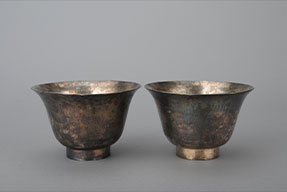
Modern Ghee Teapot
(Collected in Sichuan Museum)
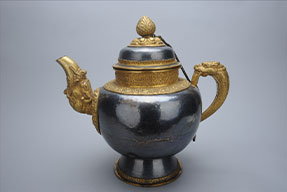
Modern Wooden Ghee Cone
(Collected in Sichuan Museum)
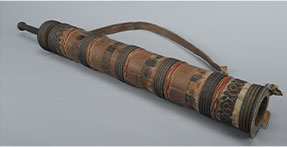
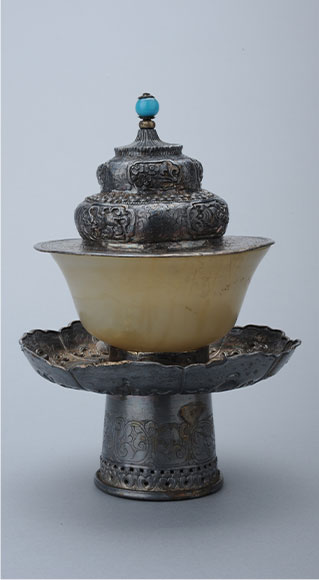
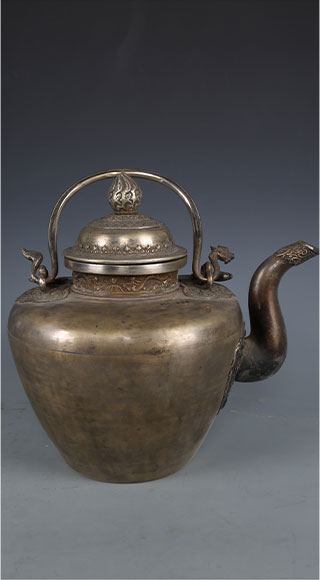
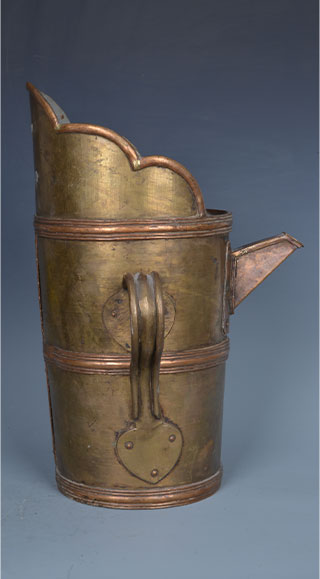
The history of horse breeding in China dates back to the Neolithic period. Starting from the Qin dynasty, the central dynasties have set up herding supervisors to directly keep horses in captivity. People of the western minority made valuable contributions to the strengthening of national defense by raising horses and not only accumulating experience in horse breeding, but also breeding large numbers of horses for the mainland.
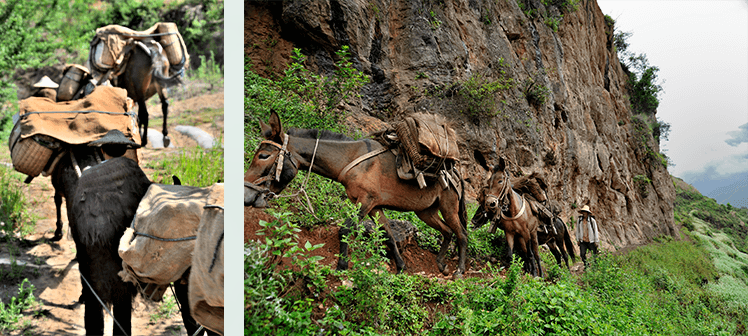
In ancient times, oxcarts and ships were the key means of transport in the Central Plains region. However, river transport was confined to watercourses, and oxcarts were far from efficient. Comparatively, horse carts and carriages had more a more advantageous position. In addition, the Central Plains region suffered frequent invasions by nomadic tribes, which resulted in social turbulences. In this context, horses became a kind of indispensible war supplies, so ancient Chinese linked the two characters “Bing” (soldier) and “Ma” (horse) to coin a phrase meaning “military forces”. Fine-bred horses, however, mainly came from areas outside the Shanhai Pass, and there were not enough funds and silk to trade for horses. As a result, the military in the Central Plains region suffered a severe shortage of horses.
In 756, Emperor Suzong of Tang pioneered the first tea-horse trading in the Uighur region. Since the Song dynasty, the ethnic minorities in the northwest, whose economy was based on animal husbandry, established the Xia, Khitan and Jin regimes, and were rivals with the Song court for a long time. At the beginning of the Song dynasty, the court bought horses from the northwest tribes and paid for them with copper coins, but on the other hand the northwest tribes used the coins to cast weapons, which undoubtedly posed a potential threat to the Song court.
As the Song court was constantly at war with the Khitan and Western Xia, they needed even more horses. These horses were first obtained from the markets in the northwest of China (today's Gansu and Shaanxi). The horses in this area were tall and suitable for use as war horses. However, as the war became more intense, the Khitan and Western Xia regimes did not easily import war horses into the Song court area for their own benefit. In 1073, the tea-horse road in Shaanxi was blocked and the source of horses from the North Road was obstructed. Since then, the Song dynasty relied on the Tubo tribes in Gansu and Qinghai, but the price of horses was so high that the Song court paid for them with silver, silk and tea instead.
Due to the minorities’ high demand for tea, the Song dynasty court also used tea-horse trade as a political tool to improve relations with diverse ethnic groups in northwestern China. Not only did the Song dynasty court shift the focus of the tea and horse exchange market to the southwest, it also stipulated for “special tea be sent there for horse trading,” and established a "tea and horse division" in Sichuan to better manage tea and horse trading, and purchased over 15,000 horses per year.
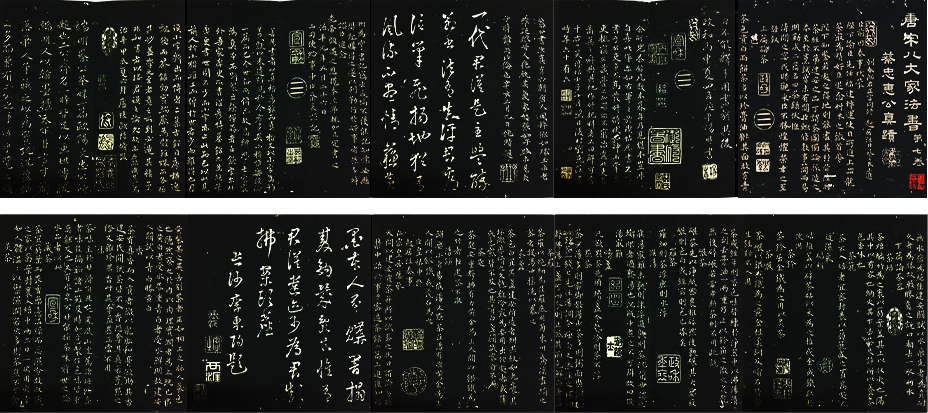
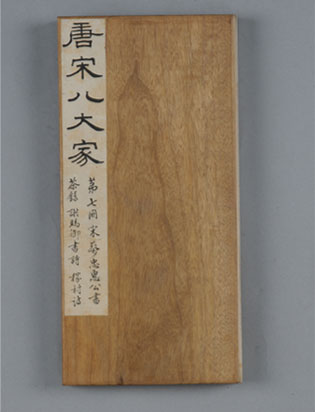 Rubbings of the Calligraphy of Eight
Great Men of Letters of Tang and Song (The Record of Tea)
Rubbings of the Calligraphy of Eight
Great Men of Letters of Tang and Song (The Record of Tea)
(Collected
in Sichuan Museum)
In the mountainous southwest regions, people can only rely on horses for travel.
Yunnan produced the legendary "Yuyi horse" during the Han dynasty. Yunnan horses became popular throughout the region during the time of the Nanzhao and Dali periods, and were dubbed "Dali horses." Yunnan horses were known for their endurance and weight bearing capacity, as well as their ability to walk over rough terrain. With a large number of Han immigrants from the mainland entering Yunnan during the Ming dynasty, Yunnan's production of goods grew rapidly, and the population grew rapidly, resulting in the simultaneous growth of products, particularly copper, salt, and tea in Yunnan, which aided the rapid growth of mule horse transportation. As a result, the horse in Yunnan was turned from a need for battle to a cargo for transportation following the Ming dynasty.
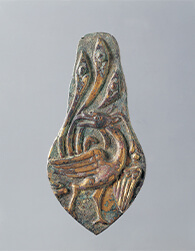 Gilt Peacock Copper Make in the Western Han
Dynasty
Gilt Peacock Copper Make in the Western Han
Dynasty
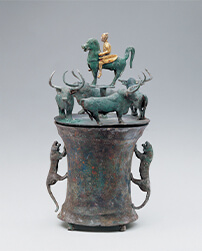 Four-Cattle Gilded Horseman Copper
Receptacle
in the Western Han Dynasty
Four-Cattle Gilded Horseman Copper
Receptacle
in the Western Han Dynasty
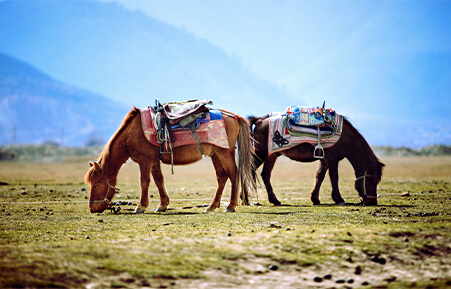
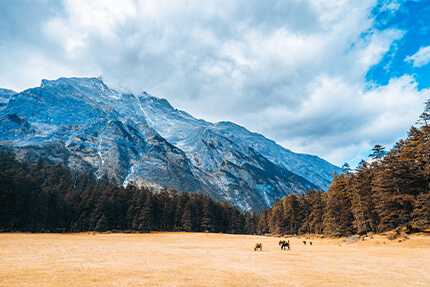
The horses, which carried the lives and materials of the ancient roads, were the foundation of the caravans' and work crews' livelihoods. The importance of horses can be seen in the variety and exquisite craftsmanship of horse-related accessories - the whip, the mouthpiece, the rowan, the bell, the stirrup, and the saddle.
Mules were also utilized as a mode of transportation by caravans traveling large distances along the historic tea horse road, in addition to horses. A mule is the offspring of a male donkey (jack) and a female horse (mare). The high roadways along the Tea Horse Road were narrow and steep. As the mule's stride was short, and its hooves and limbs constricted, it was able to walk the mountain roads with more flexibility, and its loading capacity and walking endurance greatly outstripped that of the horse.
Yak is the "sacred cow" of Tibetan people, and is the original cattle breed in Qinghai-Tibet Plateau. In the Tibetan masses to go away to pilgrimage time, in the herdsmen to transfer grazing camp time, in their need for business trade time, yak became the most important transportation tool on the plateau. People affectionately call them "the boat of the plateau".
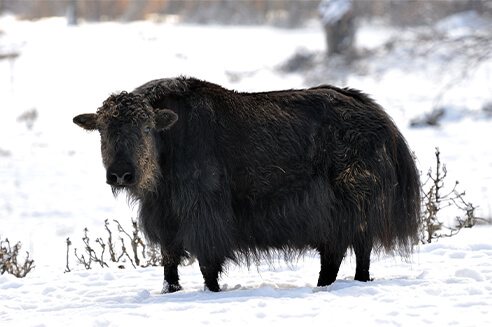
When crossing the high mountains and snow, the cargoes of the caravans are too much to go over the snowy mountains with only mule horses and manpower, so the caravans give the cargoes that they cannot carry to the yaks. Yaks have the ability to climb up high mountains in very thin air. Even the strong Yunnan mule horses struggle to ascend over the mountains, but the yaks show incredible endurance, carrying the enormous load on their backs and walking straight to the camp as if they were not carrying any weight at all.
Yak can dig up the snow layer and eat the dry grass under the snow, therefore, the merchants wouldn’t have to bring yak food. After a heavy snowfall, the potholes on the road are covered, and it is very dangerous to ride horses inadvertently into them. The yaks live on the snowy plains all year round, therefore they are sensitive to the dangerous potholes and would avoid them. When snow is too deep, the yaks would walk in the front, making the ground flat for the caravans to travel across.
As the core product for the international trade along the Ancient Tea Horse Road, tea existed based on the most fundamental human survival needs aiming to extend human life. The other goods for trade following tea were fur, musk, velvet antlers,special local products, gold and silver wares, etc. Viewing from another angle, the products revealed both the diversity of goods and the regularity of trade, and that meant the people no long took subsistence as the most fundamental needs and they hoped to live better and have better goods. The goods revealed the development. The international trade along the Ancient Tea Horse Road developed based on goods as well as it originated from goods.
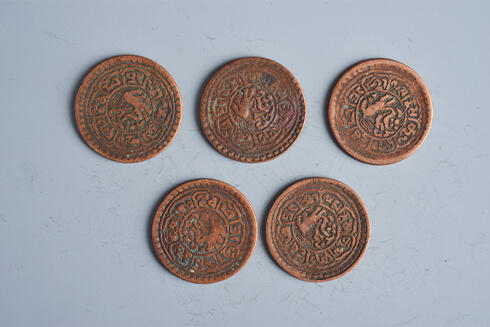
The bronze culture of Yunnan Region emerged in late Shang and early Zhou dynasties, matured during the Spring and Autumn Period and the Warring States Period, and reached its peak in the mid-Han period. The mysterious ancient Dian State belonged to the bronze culture. According to the Historical Records, in 278 B.C., Chu State sent Zhuang Jiao to lead a team to the Dianchi area, and after conquering the locals, the team’s route of return was cut off by Qin State, so Zhuang stayed in the Dianchi area and established Dian State. There is no physical materials with written records unearthed about Ancient Dian State, therefore, the social life at that time can only be traced from the figures, animals and scenes of activities portrayed in the burial objects.
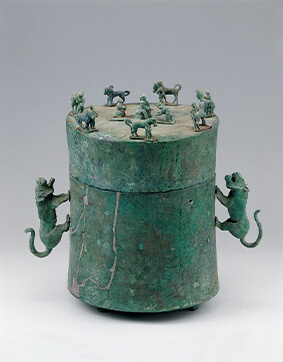 Copper
Receptacle in a Horse-training Scene in the Western Han Dynasty
Copper
Receptacle in a Horse-training Scene in the Western Han Dynasty
(Collected in Yunnan Lijiashan Copper Museum)
Although tea and horses were the main items transported on the tea horse road, salt, medicine, food, and other necessities were also essential goods on this route, especially salt. Back then, the mining and trading of salt were controlled by the government. In Tibet, long before the Tibetan Empire, different tribes had salt fields, and often had battles over the salt fields.
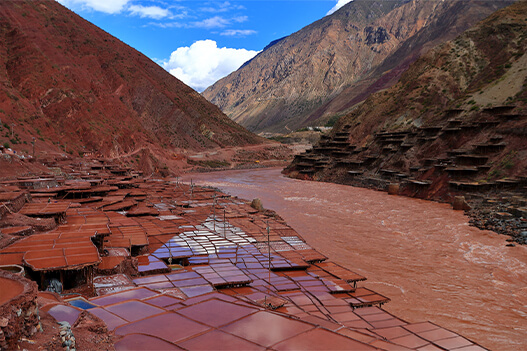
Yanjing, located on the west bank of the Lanchang River in Tibet, the terrain is gentle with large salt fields, produces red salt, called peach blossom salt. Salt has been made in Yanjing since the Tang dynasty and has lasted for more than 1,300 years. The salt ponds are like numerous mirrored worlds, reflecting the changes of the plateau. As the salt grains crystallize, they provide the plateau with essential needs of life, and they are also responsible for the stories of generations of salt well families on the thousand-year-old Tea Horse Road.
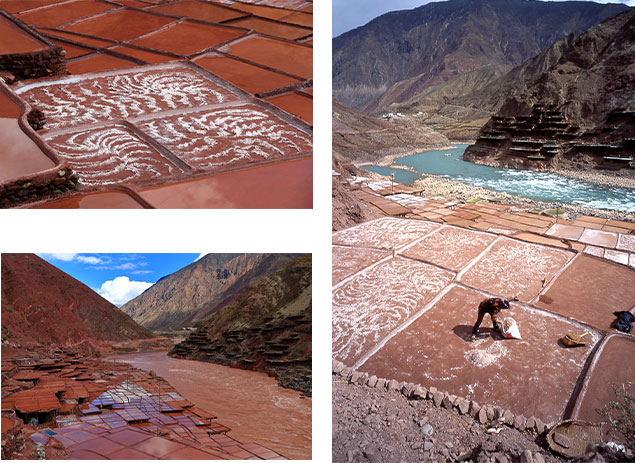
During the Qing dynasty, because of the country's vast territory at that time, the demand for more war horses weakened, and the tea and horse trade was gradually replaced by the tea trade, which developed into an industry. The materials used by the Tibetans to exchange for tea changed from horses to fur, musk, cordyceps, mother-of-pearl, and other local specialties. Meanwhile, other goods such as clothes, silk, satin, cloth, wine, meat, iron, and porcelain, were continuously sold to the Tibetan. The amount of trade exchanged between the two sides during this period even far exceeded the historical trade in tea and horses.
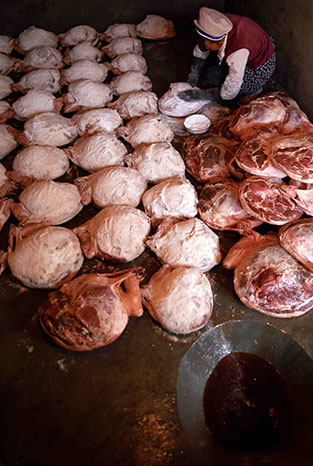
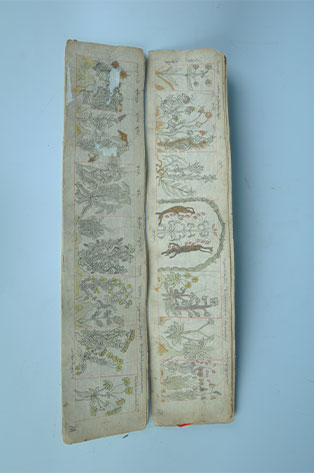
The Ancient Tea Horse Road started from the tea-producing areas of Yunnan, Sichuan and Hunan in the eastern side of Mount Hengduan in southwestern China, crossing Mount Hengduan and the valleys of the three rivers (Jinsha, Lanchang and Nujiang), and extending westward across the world's highest peaks, snow-capped mountains and grasslands, covering the Yunnan-Guizhou and Qinghai-Tibet plateaus, and finally reaching the southern Himalayas in the South Asia. It was the most ancient and complex transportation system in the world, and carried a rich culture.
The formation of the Ancient Tea Horse Road was a long process. Ancestors of the ethnic people living on the highlands built many precipitous and zigzag roads on high mountains and deep valleys by building roads, making rafts and boats and building rope ways. The Wuchi Road, the Nanyi Road, the South Silk Route, etc. built during the Qin Dynasty and the Han Dynasty laid a foundation for the formation of the Ancient Tea Horse Road.
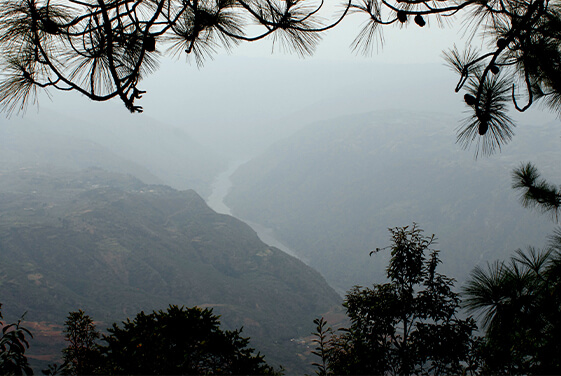
The Qinghai-Tibetan Plateau changed from an ocean into the roof of the world as a result of the slow
collision between the Indian Plate and Eurasian Plate which began about 40 million years ago. The
Himalayan orogeny caused several huge north-south fold mountains — so-called famous the Hengduan
Mountains — to form on the southeast edge of the Qinghai-Tibet Plateau.
The “most difficult” Sichuan roads lay to the east of the Qinghai-Tibet Plateau and they connected with the Loess Plateau. The regions of Yunnan, Guizhou and Sichuan with changeable landforms lay to the southeast of the Qinghai-Tibet Plateau. Some fertile Southeast Asian countries and South Asian countries lay to the south of the plateau. The ancient roads enabled ancient ethnic groups to accomplish their migration and they connected the Hengduan Mountains with the Qinghai-Tibet Plateau.
The Silk Road in northwest China is one of the earliest international transportation routes from
China to the west, but the oldest road, known by the historical name of “Shu-Yuandu Road” that
connected China to South Asia, West Asia, and Europe already existed in the southwest China more
than two hundred years before the Silk Road became accessible. “Shu” refers to Sichuan, while
“Yuandu” refere to India.
In different areas, due to the different digging time, areas
along the way and direction of roads, the Shu-Yuandu Road can also be divided into Wuchi Road,
Lingguan Road, Yongchang Road, Nanyi Road, etc. Almost all of these roads begin from the Bo Road
(now Yibin, Sichuan), which passes through Dali, Yunnan, and Shan State (now Myanmar), and finally
reaches Yuandu. These ancient roads correspond to the Silk Road in the northwest and are also
collectively called the "Southern Silk Road" by the academic circles.
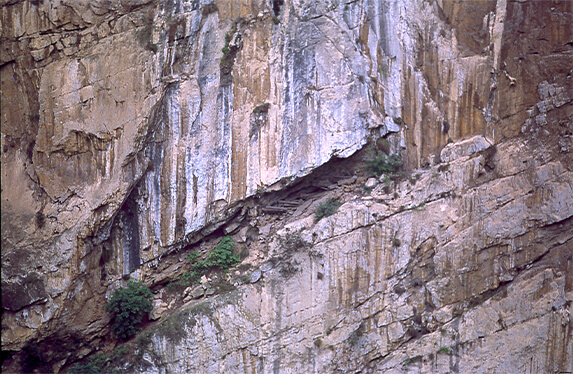
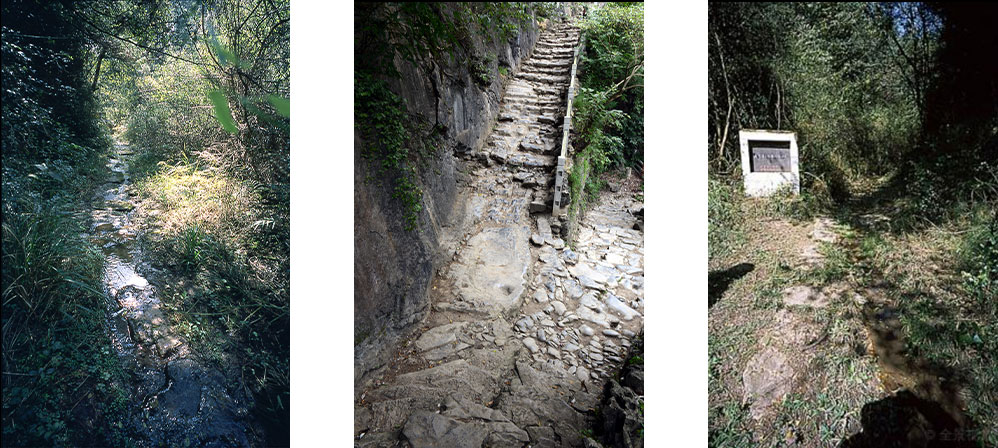
Lanjin Ancient Ferry was used for crossing the Lancang River on the road connecting Sichuan with the outside, which was opened during the reign of Emperor Mingdi of the Eastern Han Dynasty, and is the existing earliest ferry in Yunnan Province.
The Yarlung tribe in Tibet's Shannan region grew into a powerful local force in the mid-6th century CE. When Songtsen Gampo ascended to the throne, he established the Tubo Kingdom. In the early 7th century AD, the Tibetan Empire developed eastward into the Qinghai region and established multifaceted ties with the Tang dynasty. Qinghai was an important passage between Tang and the Tibetan Empire for more than two centuries, with frequent missions and commercial trade, forming the famous Ancient Tangbo Road.
The Tangbo road's total length is more than 3,000 kilometers, starting from Xi'an in Shaanxi, passing through Gansu and Qinghai, and ends in Lhasa, Tibet. According to the book of the Tang dynasty, after the first year of Emperor Taizong Zhenguan, the Tang and Tibetan envoys to and from each other as many as 142 times. This created a bridge between the Tibetans and the Chinese, therefore the Tangbo Road is also known as the "Golden Bridge".
The ancient tea horse road developed throughout time, thus forming both main roads and branches, creating many complex and varied trade channels. The development of the roads were closely linked to government control and organization of the tea and horse trade throughout the Tang and Song dynasties to the Ming and Qing dynasties.
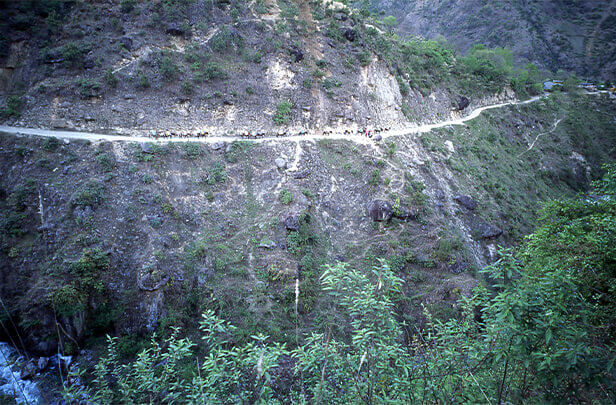
In order to maintain the peace of the frontier, the demand for war horses increased, and from the Tang dynasty onwards, successive rulers have actively taken control of the trade for tea and horses. Tang Su Zong went to the Huihu region to start the horse tea market, and pioneered the first tea and horse trading. After the An Lushan Rebellion, in order to raise grain and feed to eliminate the power of the feudal towns, the imperial court began to impose taxes on tea. Due of the huge profits brought by the tea trade, tea became a national monopoly of trade.
During the Northern Song dynasty, due to the northwest of the horse suitable for cooperation, tea and horse trade mainly in Shaanxi and Gansu, Yi Ma tea taken locally in Sichuan and Shu. However, during the period of Emperor Shenzong of Song dynasty, Shaanxi tea and horse road blocked, the Song dynasty shifted the focus of the tea and horse market to the southwest, Sichuan Ya'an became the center of the tea and horse market during this period, Ya'an's famous mountain tea is also used exclusively for Yi Ma. Therefore, "Sichuan-Tibet tea horse road" became the main area of the Song court and the Tufan tea horse trade.
Tea activities prevailed in the Song Dynasty. Based on the tea frying technique of the Tang Dynasty, the diancha method developed, which included a series of steps such as tea baking, tea grinding and rescreening, tea boiling, tea cup heating and diancha. Besides the diancha method, the doucha method also prevailed and various new teawares constantly emerged.
Gualing Handled Ewer in the Song Dynasty
(Collected in Sichuan Museum)
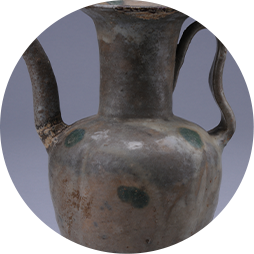
Tin Tea Tray in the Song Dynasty
(Collected in Sichuan Museum)
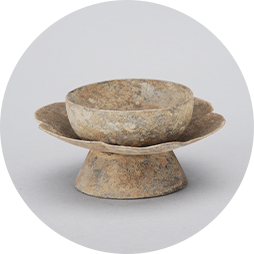
Hare's Fur Temmoku Bowl in the Song Dynasty
(Collected in Sichuan Museum)
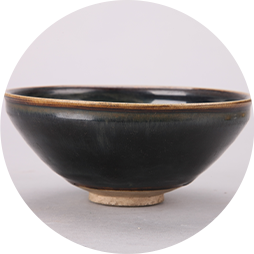
Azure Stone Handle Pot in the Song Dynasty
(Collected in Sichuan Museum)
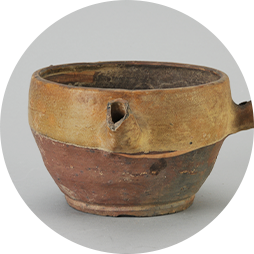
Tea Grinding Tray in the Song Dynasty
(Collected in Sichuan Museum)
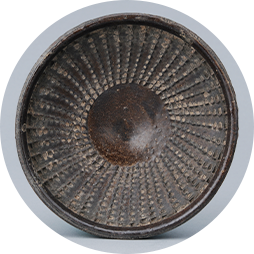
Yuan and Ming dynasties, the development of the ancient tea horse road The Yuan dynasty, the government abolished the Song dynasty, implemented the policy of tea and horse rule, but in order to ensure the smooth flow of traffic to Tibet, the Sichuan-Tibet tea and horse ancient road as the main trunk of the traffic into Tibet, and set up 19 stations for management.
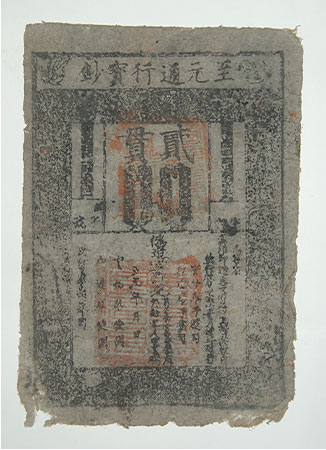
The Ming dynasty extended the Yuan dynasty of the station system. Every year millions
of pounds of tea by Kangding into Tibet, Sichuan-Tibet tea horse ancient road
economic value increased greatly. At the same time, the Ming rulers also
strengthened the construction of Yunnan-Tibet tea horse road, becoming an important
channel to the mainland of Yunnan, because of the Tibetan people's love of Pu-erh
tea, Yunnan tea into Tibet has also been increasing. However, with the expansion of
Lijiang Muji Tusi City, the transportation between Yunnan and Tibet was once
interrupted.

Tea-Horse Trade Bulletin in the Ming Dynasty (Collected in Qinghai Provincial Museum)
The Development of Tea Transportation and Trade in the Qing Dynasty The Qing dynasty also regarded tea and horses as important military policies, and the tea and horse market was still an important political and economic means for the Qing dynasty rulers to stabilize the borders. Trade was limited to the government, strictly prohibiting private trade at the early Qing dynasty . The Qing court ordered that tea be divided into official tea for horse trading, commercial tea for taxation, and tribute tea for tribute.
By the Qianlong dynasty, the tea horse market was often interrupted for various reasons, and huge profits led to corrupt officials and unscrupulous businessmen seeking to monopolize the tea mountain trade, making it difficult to implement the government-run tea horse market system, which was replaced by the business-led side tea trade system. “Side tea” is the special tea for China to sell to the Tibetan region, At that time, other than trading tea, the Tibetans traded goods not limited to horses, leather, herbs, and gold.
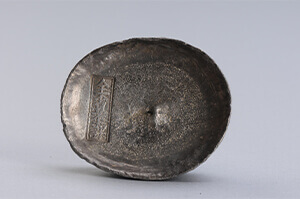 Province Tea Tax Silver Ingots in the Qing Dynasty
Province Tea Tax Silver Ingots in the Qing Dynasty 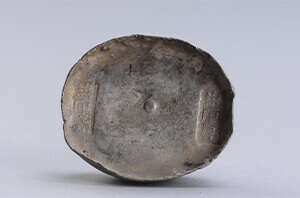 Silver Ingots of Salt Bureau in the Qing Dynasty
Silver Ingots of Salt Bureau in the Qing DynastyThe tea horse road was not a completely fixed single route, but a complex transportation network. In different historical periods, different dynasties, and even in different stages of the dynasties, the road had different routes, changing throughout time. However, there are two main routes, one is the Sichuan-Tibet tea horse road from Ya'an, Sichuan, and the other is the Yunnan-Tibet tea horse road from Simao, Pu'er and other places in Yunnan. Their starting points are tea-producing places, along the main route will extend numerous branches, like a huge net to the Yunnan-Tibet-Sichuan triangle closely connected together.
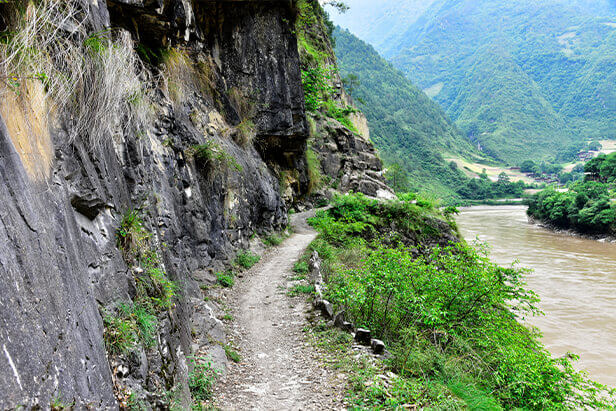
The Sichuan-Tibetan Tea Horse Road started from Ya'an in Sichuan, and went westward through Luling, Kangding, Batang, Changdu to Lhasa, then to Nepal and India. Then through the Dadu River, Yarlung River, Lanchang River, Nu River, Yarlung Tsangpo River, Lhasa River. Over the snow-capped mountains such as Jinggongla and Nugongla, passing through steep slopes, ravines, and cliffs, connects the basic needs of the people of China and Tibet.
Luding has always been an important station on the ancient tea horse road. Without a bridge, caravans and travelers had to take wooden or leather boats to cross the Dadu River. The river rushes rapidly at more than 100 meters wide, which makes crossing the waters very dangerous.
In order to consolidate the frontier to protect the smooth flow of the tea road in 1706 AD in Kangxi, the Sichuan governor submitted a proposal to build a bridge. In addition to the special permission and imperial edict of Kangxi, the bridge was also personally renamed "Luding Bridge" and made the "Royal Luding Bridge Monument". After the completion of the Luding Bridge, it ended the history of the tea transporting caravans and relying on boats to cross the river.
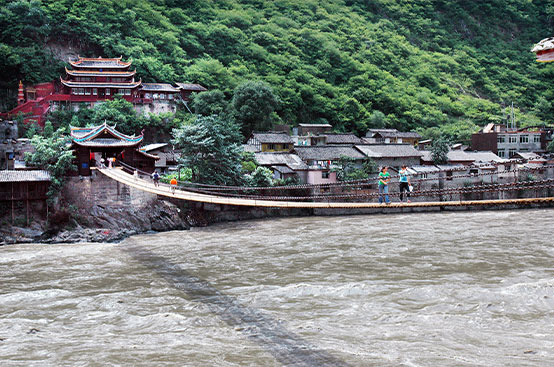
The Yunnan-Tibet Tea Horse Road started from Simao and Pu'er in Yunnan. It went north through Dali,
Lijiang, Shangri-La; Dechen to Bangda, Chamdo, Lolong, Linzhi, and Lhasa in Tibet. Then iit through
Gyantse and Yadong to Burma, Nepal, and India.
The rising of the Yunnan-Tibet route
during the Tang dynasty was closely related to the expansion of the Tibetan Empire and its trade
activities with the southern imperial emperor. In 678 A.D, the Tibetan Empire entered the northern
part of the Western Erhai region in Yunnan. With the tea and horse trade being an important element,
trade between the two sides also developed significantly.
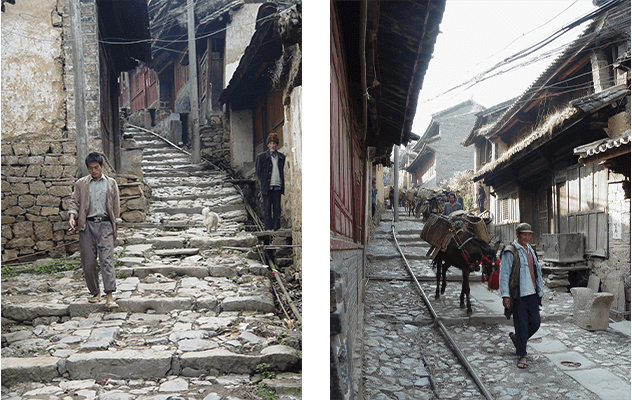
The southern section of the Yunnan-Tibetan Tea Horse Road is located in Lincang, Yunnan Province. The main road is centered on Lincang, going west to Zhenkang to reach the coast of Burma, then to the rest of the world. In addition, Linchang connects the surrounding counties, trading tea and salt by crossing the Lanchang River with the Xigui ferry.
The ancient Tea Horse Road extends from Lhasa to a number of roads into India, Bhutan, and Nepal. For thousands of years, the Himalayas have been a natural barrier between the Qinghai-Tibet Plateau and South Asia. However, people kept traveling through the mountains, ignoring the existence of this barrier. The countless river valleys and hills that pass between the mountains have become the paths of communication and exchange for the people. The Chinese, Tibetans, Indians, Bhutanese, and Nepalese have all passed through these mountain paths, and have connected the cultures and civilizations of different regions.

The ancient tea horse road was a route that was created by the people. This road displayed how human beings lived in harmony with nature, and the cultural richness integrating ethnicity, faith, and culture. The route formed a network for the ethnic minorities of the Yunnan, Sichuan and Tibetan regions, and the movement of people drives the circulation of languages, customs and beliefs, deepening people's knowledge and understanding of one another, while maintaining the diverse cultural characteristics of each ethnic group.
The Ancient Tea-Horse Road appears to be the artery connecting northwest and southwest China, as well as South and Central Asia, and the caravans transported important daily supplies to the snowy plateau. These teams not only brought diverse sorts of supplies, but also led to the establishment of towns and cities, as well as the development of the region's local customs in the direction of richness and diversity, thanks to their ancient and basic survival expertise.
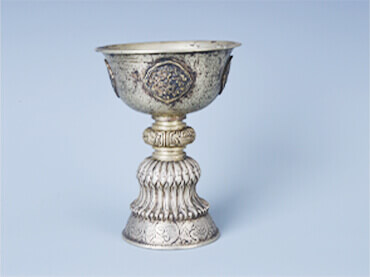 Burin Silver Lamp in the Qing Dynasty
Burin Silver Lamp in the Qing Dynasty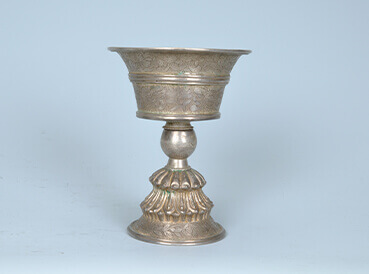 Burin Engraved Silver Lamp in the Qing
Dynasty
Burin Engraved Silver Lamp in the Qing
Dynasty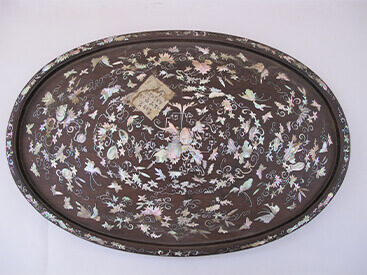 Large Oval Plate with Inlaid Studded Inlay in the
Republic of China
Large Oval Plate with Inlaid Studded Inlay in the
Republic of China 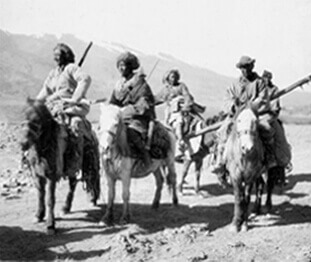 Caravan in the Early 20th Century
Caravan in the Early 20th Century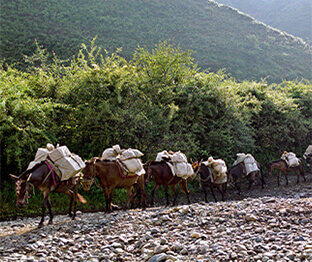 Modern Caravan
Modern CaravanA caravan refers to a team of horses carrying goods, and is a group of farmers who raise horses for “long-distance transportation”. However, due to the treacherous journey, the caravans often had to travel for over half a year to complete a tea and horse trade, and often a large number of mules and horsemen disappeared along the way. However, in order to make a living, people on the plateau set out to deliver tea leaves from the tea-producing areas, which resulted in a linkage between the Hengduan Mountains with the Tibetan plateau.
On the ancient road, people used to call the horse riders, "horse feet". Most of them came from a poor background, their lifestyle forced them to become horse riders. As the road is dangerous, horse riders must have sufficient skills and ability. First, to determine the right time and place to travel, be able to see the changes in weather, to choose the right road, and also choose their camp. They also had to communicate in the language of various nationalities, and trade with different local people of all kinds. Moreover, to know the temperament of the mule horse; finally, to know survival skills, such as setting up tents, cooking, chop wood, create fire, and look for animal feed, and even medical treatments.
Due to Sichuan lacking horses and mules for traveling in the mountainous plateaus, Sichuan tea is mostly transported to Tibet by human labor. Back then, poor farmers in the northwestern region of Sichuan left their homes to carry tea leaves on the ancient Sichuan-Tibet tea road. One backpacker carried at least more than one hundred pounds of tea bags. They carry the tea from Ya'an to Kangding, taking more than a month per trip, traveling more than 20 miles a day.
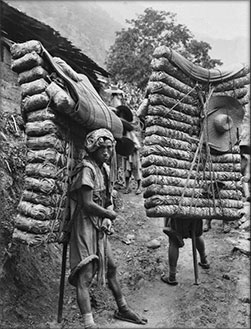
Tea is regarded as a noble and elegant object by all nationalities, despite the fact that each has its own language, attire, conventions, habits, beliefs, and reverence, as well as its own unique philosophy and practices.
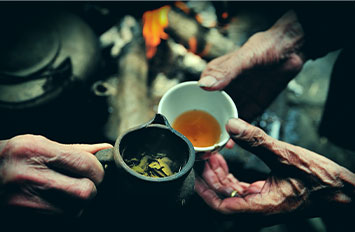
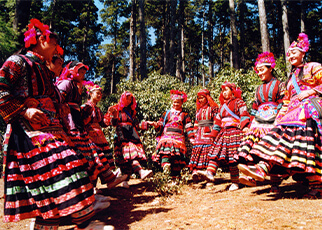
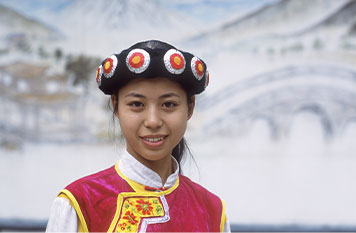
The Wa people inhabit mountain areas with much fog and many clouds, where the slope gradient of farmland is large and the farm work is very arduous. The Wa people like to drink the tea with a strong tea smell made by simmering fresh coarse leaves of daye tea before and after they go up mountains and labor. After the tea is simply baked, it is placed in an earth pot and slowly simmered. Before it is drunk, a little salt is added to it. It can not only refresh the drinker, but also supplement salt to the drinker. Lei tea is a very old tea drinking method of Wa people. Lei tea is made by mixing tea leaves, ginger, bay and salt, putting the mixture in an earth pot and boiling it.
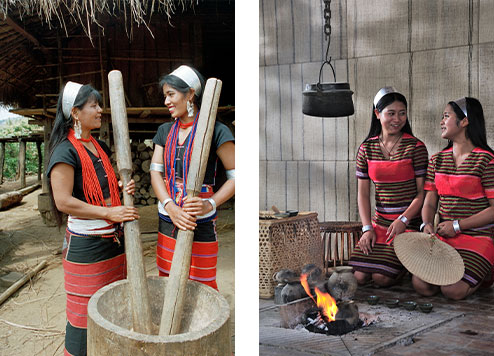
The Brown tribe, one of the earliest tea-growing ethnic groups, is known as the "thousand-year tea farmer," and lives primarily in Brown and Jingmai Mountains. For a long time, when the Brown people left their villages to work in the mountains or hunt in the wild, they would take local materials, pick fresh and tender tea leaves, cut sturdy bamboo tubes, fill them with clear mountain spring water, boil and roast them to make green bamboo tea.
It is not an exaggeration to say that Hani people can be found wherever there are
ancient tea trees and large tea plantations. Tea and people are inseparable in
the Hani people's lives.
The Hani people enjoy drinking tea in an earthen pot, which is an ancient method
of drinking tea. First, they use a large pot to boil the mountain spring water,
then add the specially made tea leaves, boil for a few minutes until the tea is
green and yellow, then ladle into a bamboo tea cup to drink. They enjoy sitting
down with their families to drink tea and bond, and when they have visitors,
they would make this tea for them as if they were distant relatives.
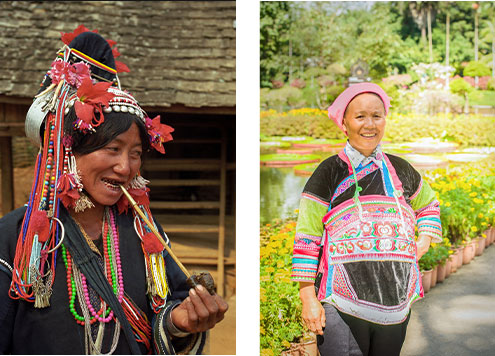
The Jino people live deep in the ancient tea mountains of Youle, and are known as "tea eaters". They are good at growing, making, and eating tea, especially "cold tea". They pick fresh tea leaves, rub them with their hands, then add chopped garlic, chili pepper, salt, and a little spring water, and then stir them with chopsticks for better flavor, and leave them out for a while before eating. To them, herbal tea is more like a dish that brings out the best flavor of tea leaves, sour, sweet, bitter, spicy and salty.
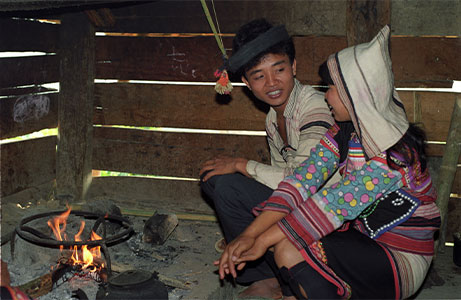
In the language of the Lahu people, la means tiger and hu means roasting meat. Therefore, the Lahu people are historically called "the people hunting tigers". The Lahu people like to drink roast tea and coach. Roast tea is made by placing tea in a pot, roasting the tea until it becomes brown, waiting until nice tea scent can be smelled, adding some water to the tea and boiling it for a while. Caocha is made by picking tender fresh tea leaves, putting them in a wok, boiling it until it is half-boiled, taking them from the wok, placing them in a thick bamboo tube and storing them there. When a meal is ready, take a little caocha out of the bamboo tube, and caocha can be drunk after it is boiled in water.
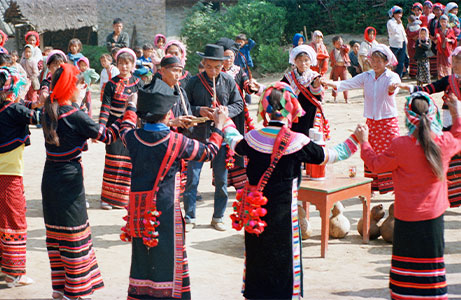
The towns along the ancient tea-horse road benefited greatly from the development of commerce, and many cities sprang up as a result of the ancient tea-horse road. In Yunnan, for example, Yiwu, Simao, Lijiang, and Zhongdian, in Sichuan, Ya'an, Luling, Kangding, Litang, and Ganzi, and Tibet, Changdu. These cities were accompanied by the passage of the ancient tea horse road and gathered merchants, people, and stores, and then formed a town and flourished.
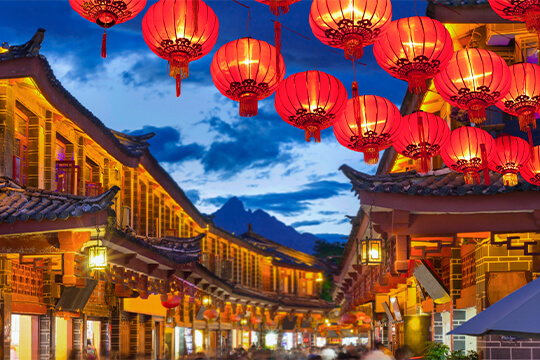
Pu'er was originally known as "Simao," a city renamed after Pu'er tea. Simao was historically one of the starting points of the Yunnan-Tibetan Tea Horse Road, and today, Pu'er is the center of the world's original tea tree production area, as well as one of the original Pu'er tea production areas. There are nearly 80,000 mu of wild ancient tea tree communities in Pu'er City's 29 dense forests of seven counties, including two wild tea king trees over 2,700 years old and 2,500 years old in Qianjiazhai, Zhen Yuan County; two wild ancient tea trees over 1,000 years old in Ji Lu Shan and Ban Shan, Pu'er County; a wild ancient tea tree over 1,000 years old in Zheng Xing, Jinggu County; and a transitional ancient tea tree over 1,000 years old in Bang Wei, Lanchang County; and 10,000 mu of cultivated ancient tea gardens over 1,000 years old in Jing Mai and Mang Jing villages.
Lijiang is located at the crossroads of Yunnan, Sichuan, and Tibet, where trade, religious, and ethnic cultural exchanges have historically converged. The Naxi ancestors traded cloth, silk, salt, iron, and animal products with Han merchants in Sichuan as early as the Han and Jin dynasties. Since the early Qing dynasty, the Naxi region, which has gradually developed economically, has thrived in trade with neighboring Tibetan areas. Many Naxi merchants went to Tibetan areas to do business, primarily selling tea, silk, and brassware from the mainland. Some of the larger firms included the Niu family's "Yuchunhe," the Lai family's "Renhechang," and the Li family's "Yongxing," among others, and eventually expanded to more than 30 firms.Consequently, Tibetan and other merchants from all over the world opened a number of shops, and Lijiang gradually became a transit point for various caravans.
Kangding is known to the people of Taiwan by a popular song. Kangding used to be called the "archery furnace" and is an ancient city with a long history on the plateau. The ancient city is surrounded by three mountains and two rivers, with the Zheduo River running through the city, and a variety of ethnic-style buildings scattered on both sides of the river. The sound of folk songs, the dance of the people, is rich in the characteristics of the plateau ethnic customs. In 1696, Emperor Kangxi approved the request of tea and horse trading in Kangding, making it the main commercial center between the mainland and Tibetan areas.
Ya'an, Sichuan Province, is well-known as the origin of "side tea" and has long served as the main production and trading distribution center for the product. The humid climate, plentiful precipitation, and acidic soil have created ideal growing conditions for tea trees. At the same time, because Ya'an borders the Tibetan region, the Chinese and Tibetan sides communicated and gradually developed their "tea-for-horse" form of trade, with tea as the main content.
Chamdo, which means "meeting of two rivers" in Tibetan, is the political and cultural hub of eastern Tibet, located in the upper basin of the Lanchang River. It is across the river from Dege and Baiyu in Sichuan Province in the east, borders Dechin in Yunnan in the southeast, is close to Linzhi in the southwest, connects to Nagqu in the northwest, and intersects with Yushu in Qinghai in the north. The Changdu area has an average elevation of nearly 3,500 meters, and several of the peaks rise over the snow line. The Changdu area also contains the majority of the 25 holy mountains in the Tibetan province of Khampa. Chamdo's tourist resources include both natural and human landscapes, as well as a rich history and culture.
Lhasa is the capital of the Tibet Autonomous Region and the country's political, economic, and cultural center. With the growth and popularity of the tea-horse trade, folk commerce flourished here, monasteries and nobles joined in, founding a variety of commercial organizations. Lhasa's private businessmen to the west of the southern Himalayan foothills around and India, Nepal side to do business, to the north and Qinghai, Gansu trade to and from, to the east and south and Sichuan, Shaanxi, Yunnan merchants trading tea mountain goods, which makes Lhasa truly become the Qinghai-Tibet Plateau and the Hengduan Mountains trade center, a time on the streets tea, cloth, fur, gold and silver jewelry, satin, herbs, food and other stores.
The tea-horse road is in a unique location, with the Hengduan Mountains, the western and northwestern part of the road connecting to the Tibetan Plateau, the eastern part adjacent to the vast Mainland, and the southern and southwestern part adjacent to South and Southeast Asia, which is located in the world Buddhist cultural circle, thus forming a Buddhist culture as the main religious culture in this area, where Han Buddhism, Tibetan Buddhism, and Theravada Buddhism are practiced.
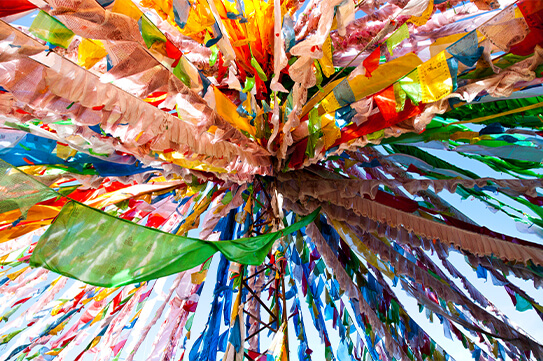
The Central Plains tea culture spread westward and northward, and Buddhism originated with Princess Wencheng's entry into Tibet, while Indian Buddhist monks were also formally introduced into Tibet. After more than a century of mutual integration with the original Tibetan religion, Tibetan Buddhism was finally formed, and gained significant development in the second half of the eighth century CE, which flourished with the expansion of the Tubo military and political power.
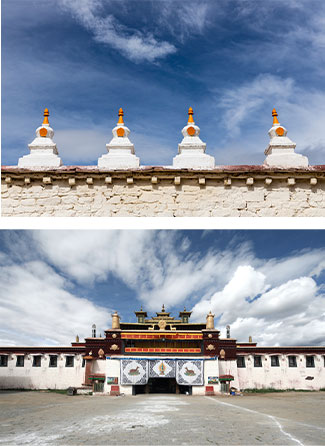 Sangye Monastery
Sangye MonasteryThe Sakya school was strongly supported by the rulers during the Yuan dynasty, and religious exchanges between the Central Plains and Tibet increased significantly. This left numerous Tibetan Buddhist imprints on the Wutai Mountains in Shanxi, the White Pagoda of Miaoying Temple in Beijing, and the cliff statues of Fei Lai Peak in Hangzhou. Similarly, Buddhism left traces in Tibetan areas, such as the sculptures, paintings, and architecture of Sakya and Shalu monasteries, which retain a huge number of Mainland Buddhist art forms, and silk, which was highly influenced by the Central Plains. Tibetan Buddhism became a popular belief among Mongolians and Manchus throughout the Qing era, and monasteries sprang along the historic tea-horse route, with monks and lamas traveling often.
Pilgrims are frequently seen traveling to the holy city of Lhasa on the tea horse road. They walk alone on the rugged winding mountain road, some prostrated on the ground, they would prostrate until their limbs ulcerated, blood dripping from the face, but their eyes light up with peace and certainty of faith.
There is no definitive answer as to the time of Buddhism’s introduction into Yunnan. The coexistence of Chinese, Tibetan, and Theravada Buddhism is a major feature of Yunnan's Buddhist culture. Tibetan Buddhism was introduced to the northwest of Yunnan in the early Tang Dynasty due to the rise of the Tubo; at the same time, the Tang Dynasty supported Menghanzhao to establish Nanzhao Kingdom in order to contain the power of the Tubo, and Chinese Buddhism was introduced on a large scale; Theravada Buddhism was first introduced to Xishuangbanna around the 7th century AD, and became popular among many minority groups.
After the Song Dynasty, the spreading pattern of Buddhism in Yunnan gradually took shape, and its distribution showed obvious ethnic and regional characteristics: Tibetan and Naxi ethnic groups in northwest Yunnan have believed in Tibetan Vajrayana Buddhism for generations; the Dai, Blang, and De'ang ethnic groups in Xishuangbanna, Dehong, and Honghe in southern Yunnan have believed in Theravada Buddhism; Mahayana Buddhism has been esteemed and practiced by many ethnic groups in central and eastern Yunnan.
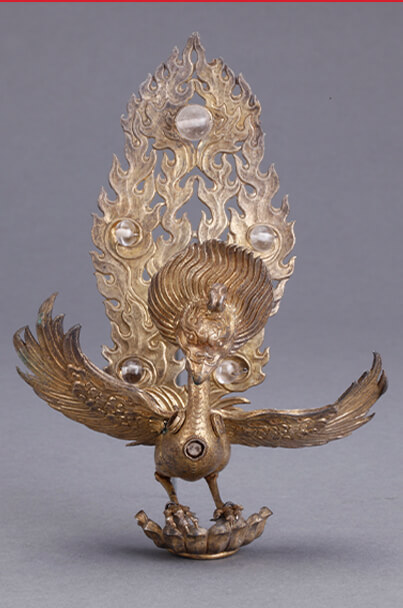 Dali State Silver-gilt Bead-encrusted
Golden-winged Bird
Dali State Silver-gilt Bead-encrusted
Golden-winged Bird
The spread of Buddhism in Yunnan was also facilitated by preference of rulers of Nanshao and Dali. In the over-500-year period from 738 AD when the Kingdom of Nanzhao was established Piluoge with the confirmation of the Tang Dynasty to 1253 AD when the Kingdom of Dali was destroyed, rulers of Nanshao and Dali regarded Buddhism as the state religion and all the people believed in Buddhism.
Dali State Silver-backlit Gold Asagaya Guanyin statue
(Collected in Yunnan Provincial Museum)
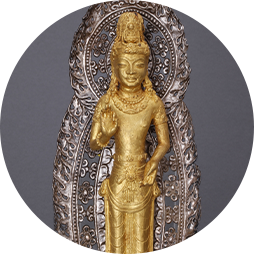
Dali State Engraved Buddha Gold Plate
(Collected in Yunnan Provincial
Museum)
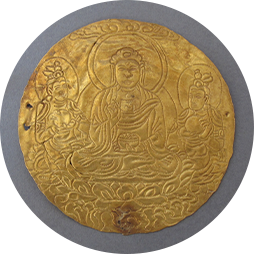
Dali State Copper-gilt Nine-stranded Vajra
(Collected in Yunnan Provincial Museum)
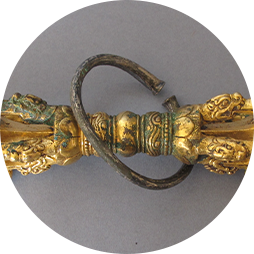
Copper Standing Statue of Vajravarahi in the Qing Dynasty
(Collected in Yunnan Provincial Museum)
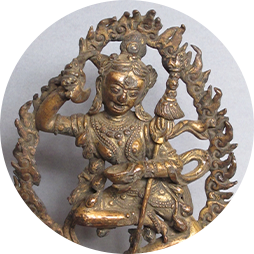
Copper Seated Statue of Sakyamuni Buddha in the Qing Dynasty
(Collected in Yunnan Provincial Museum)
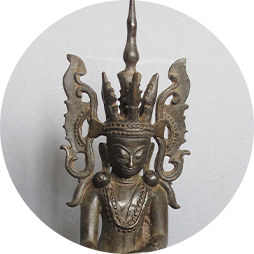
Taking the development history of the Kingdom of Nanshao as the main contents, a
vivid scroll painting on the history of the Kingdom of Nanshao was completed in
Shizhongshan Grottoes.
Shizhongshan Grottoes was dug for the period from the Kingdom of Nanshao to the
Kingdom of Dali. The digging was carried out over 1,000 years ago. Shizhongshan
Grottoes is the earliest, largest and best-preserved grotto group in Yunnan
Province. There were 139 Buddha statues in the grottoes. Statues of the three
kings of Nanshao with most outstanding merits and achievements were also found
in the grottoes.
Lijiang, which was once under the jurisdiction of the Southern imperial court and
Dali, was a significant center for Tibetan Buddhism. Specifically, between
Kangxi and Daoguang in the Qing dynasty, Lijiang built 13 major monasteries of
the Kagyu school of Tibetan Buddhism with religious and economic
power.
Lijiang's northern outskirts, as well as its border with
Sichuan, have become the most powerful Gelu sect of Tibetan Buddhism. Fuguo
Temple, Wenfeng Temple, Zhiyun Temple, Puji Temple, and Yupeng Temple are all
Tibetan Buddhist monasteries, and their architecture is compatible with Han,
Naxi, and Bai ethnic styles. The famous Lijiang murals have been preserved,
mostly in the Tibetan style, and some are Tibetan paintings themselves.
As Tibetan Buddhism spread eastward, Tibetan pilgrimages to China became more common, and a large “return flow” developed. Monks of all sects in Tibet make pilgrimages to Lhasa for further studies. To become a Geshe (a title equal to a doctorate degree in Buddhist studies), a monk must study for a long period and take an examination at one of Lhasa’s three major monasteries. As Tibetan Buddhists depend on caravans to travel between China and Tibet, religious culture was spread among various ethnicities in the region.
The ancient tea horse road has displayed the Chinese spirit of pioneering, aggressiveness, and camaraderie through thousands of years. Tea served as an abstract symbol of national feelings and national solidarity between the mainland and the frontier peoples.
From the distant Qin and Han dynasties, through the Tang and Song dynasties’ tea and horse markets, to the Ming and Qing dynasties’ expansion of the Yunnan-Tibet and Sichuan-Tibet routes, the ancient tea horse road has served as a large corridor for nearly 2,000 years, driving the exchange of commodities among various ethnic groups and making the regions economically and mutually dependent. Along the route, the arts, religions, and customs blossomed like never before, and each nationality’s distinct ethnic culture coexisted in a multicultural context, accommodating, absorbing, and influencing each other in subtle ways. The ethnic barriers between ethnic groups were broken down as a result of this process, and the ethnic minority of the southwest frontier were gradually assimilated into the broad scope of Chinese national culture, boosting national unity and identity.
The ancient tea horse road also connected China’s southwest frontier region with the international market, making it the frontline of China’s engagement with Southeast Asia and South Asia, and allowing it to be swept farther into the wave of globalization in modern times.